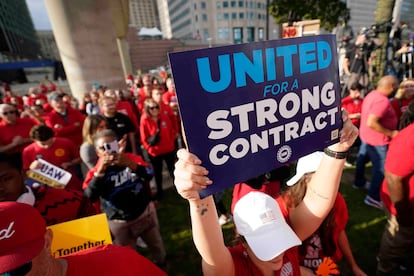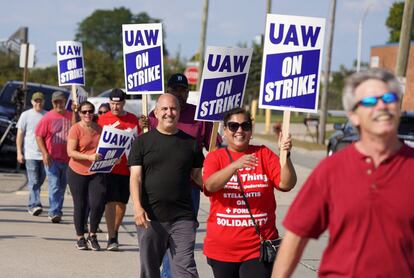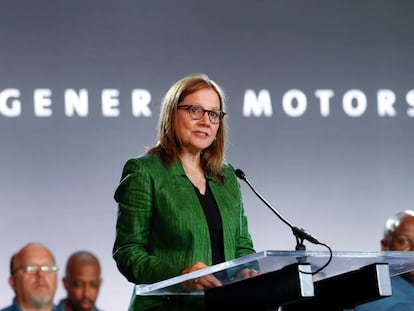US car giants gripped by history-making strike
Autoworkers are fighting to stay in the middle class in a conflict that will have a far-reaching impact on labor, industry and politics

It’s noon on Friday, September 22 in Ypsilanti (Michigan), about 40 miles from Detroit. The vast majority of workers at a General Motors component distribution center are beginning to leave the plant. They get into their cars and leave honking and shouting slogans. They don’t go very far. They park as soon as they leave the premises, get out of their cars, hand out banners and form a picket line. “It’s a historic moment,” says Michael Martin, 59, the center’s engagement manager. The workers are taking part in a strike destined to mark an era with its far-reaching repercussions on labor, industry and politics. “Inequality” and “injustice” are the words that are most often repeated by the striking workers, dozens of whom spoke EL PAÍS to this past week. They are fighting to stay in the middle class.
The scene in Ypsilanti is being repeated in 37 other facilities throughout the United States. The workers are following the call of the leader of the United Auto Workers (UAW) union, Shawn Fain, who at 10 a.m. addressed them on Facebook and YouTube to ask them to join the historic strike, the first to hit the Detroit Big Three — General Motors, Ford and Stellanis — at the same time. The strike began last week with a work stoppage at a General Motors plant in Wentzville (Missouri), which manufactures the GMC Canyon and the Colorado; a strike at Ford in Wayne (Michigan), which assembles the Bronco model and the Ranger truck, and a third at a Jeep plant Jeep, from Stellantis, in Toledo (Ohio), where the Gladiator and Wrangler models are made.
The strike is called Stand Up, a nod to the historic Sit-Down Strike that took place almost a century ago, in the midst of the Great Depression. That strike started on December 28, 1936 in a General Motors body plant in Flint (Michigan) due to the dismissal of two brothers. The workers left the production line and sat in the factory. By staying, they avoided police repression, external pressures, inclement weather (although not heating cuts) and being replaced by scabs. After 44 days of tension and battles, GM — which at that time the largest company in the world — granted a 5% wage increase, allowed workers to talk about union issues in the cafeteria, recognized their right to unionize and admitted the UAW as an interlocutor.
After that success, the union went from 30,000 to 500,000 members in one year, with workers signing up from across the sector. One of the heroes of that strike was Walter Reuther, the legendary union leader who took charge of the UAW in its golden age. In 1950, he signed with General Motors the so-called Reuther Treaty of Detroit, a collective agreement that — in exchange for avoiding strikes — granted health coverage, pensions, the right to unemployment, more vacations and salary increases. The UAW reached similar agreements with Ford and Chrysler. For autoworkers, the doors to the middle class were wide open. In the following decades they were able to afford a good car, a good house and to send their children to university... The Big Three, benefiting from protectionist measures in the U.S. and a buoyant economy, could afford it.
But competition from foreign cars, creeping inefficiencies, lack of innovation and deteriorating quality led large American manufacturers to rapidly lose market share and profitability in the 1980s and 1990s. On the eve of the 2008 financial crisis, the sector’s viability was under threat and the unions agreed to make sacrifices. The financial crisis caused the bankruptcy of GM and Chrysler (later acquired by Fiat and integrated into Stellantis), the government’s decision to bail out the sector and the general restructuring of companies, with plant closures, cost cuts and union concessions. Companies have since bounced back, and in recent years, recorded multimillion-dollar profits. But workers believe these profits have not been distributed fairly.
Hal Jomaa, 60, is a group leader at the Jeep (Stellantis) assembly plant in Toledo, Ohio, where he has been working all his life, more than 40 years. This, however, is the first time he has been on strike. “We are defending our way of life, trying to get enough money to take care of our families and stay in the middle class. They work hard here, six days a week, 10 hours a day. We don’t see our family, and we have to work longer hours to earn the same as what we did 20 years ago,” he said Friday at the doors of the factory, dressed in red, the color representing the workers on strike.
Shawn Fain, 54, is the union’s first president to be elected by all its members and not by delegates. Since taking office last March, he has struck a combative tone. In a live video on Friday, in which he appeared dressed in camouflage, like a kind of guerrilla leader, he invited the president of the United States to join the picket line. Joe Biden has taken up the gauntlet, saying in a message on X that he will join the protest on Tuesday in Michigan.

Fain has nodded to the past by calling the strike Stand Up, while at the same time, he has changed up the strategy. Historically the UAW prioritized making an agreement with one of the Big Three, by striking if necessary, and then demanded that the other two matched the conditions. Fain, however, has dared to take on all three at once, but with a selective strike. It started with a strike at one factory from each company, with only about 13,000 of the almost 150,000 workers affiliated with those companies walking off the job. “This strategy will keep the companies guessing. It will give our national negotiators maximum leverage and flexibility in bargaining, and if we need to go all out, we will,” Fain said in explaining his plan.
This approach allows him to use both the carrot and the stick: on Friday, he called for another 6,000 workers from 38 facilities of Stellantis and GM to stand down. Ford was spared for having shown a greater willingness to negotiate. At the same time, this strategy allows the UAW to preserve the $845 million fund to compensate striking workers, who receive $500 a month. The factories chosen so far produce profitable models, but Fain still has the option of calling a strike at the plants that produce Detroit’s bestsellers, such as the Ford F-150 and Stellantis’ Ram Trucks, which represent a huge part of company revenue. The Big Three and some of their suppliers have laid off about 6,000 workers in moves they say are related to the strike and the bottlenecks it may lead to.
The workers seem willing to follow the pace set by Fain: “It’s a new day. We have to try new tactics. We can’t try to do the same things and play the same games. We have played the game they wanted and here we are working, earning less, living from paycheck to paycheck. We can’t live like this, not for the next four years,” said Michael Martin at the GM plant in Ypsilanti. “It is strategic,” agreed Jomaa at Stellantis in Toledo. Justin Nelson III, 48, who has worked as a painter at the Ford factory in Wayne for 27 years, used that same word Thursday. “It seems that it’s upsetting the companies,” he added.
The UAW’s list of demands is long. It includes a 32-hour work week that does not seem a priority, and focuses on three points: increased salaries and pensions, eliminating the tiered wage system, in which new employees make half ($16 per hour) of incumbent workers, and guarantees for workers at the automakers’ electric vehicle battery plants.
The union is demanding that pensions be adjusted to the cost of living and a salary increase of 40% in four years. According to its calculations, the CEOs of the Big Three have seen their salaries rise by that much in that time period. Indeed, the executive’s multimillion-dollar salaries have inflamed tempers and helped catalyze the protest. Guadalupe Pérez, 64, from Tamaulipas (Mexico), who works on the line at the Toledo (Ohio) assembly plant, believes that the company is treating workers “unfairly.” “I’ve been working here for 40 years and I haven’t received a raise in 10 or 12 years, and they [the executives] are making a lot of money.” “We made a lot of concessions in 2008, but now it’s 2023 and inflation is skyrocketing, everything is through the roof, and we’re just asking for something back. We didn’t even ask for more than we had before. We are only asking what we would have had with things in their place,” explained Justin Nelson III.
“Inequality is the huge background of this strike, with the gap between the remuneration of managers in the automobile industry and that of workers as an understandable grievance,” Chuck Collins, who directs the Inequality Program and the Institute of Political Studies in Washington, told EL PAÍS. “After 40 years of wage stagnation, and a pandemic in which income and increased wealth have gone primarily to the richest 1%, the UAW and other workers believe they should share in the productivity increases of recent decades.”
According to the Economic Policy Institute (EPI), a think tank with 37 years of history, pay packages of top executives have risen 1,460% since 1978, while average workers have only seen their salaries rise by 18%. In the 350 large listed companies, the CEO earns 399 times what a typical employee makes. That ratio was 20 to 1 in 1965, and 59 to 1 in 1989. In the case of the Big Three, an average Stellantis worker would have to work 365 years to make what the company CEO, Carlos Tavares, earned in 2022. General Motors (GM) CEO Mary Barra earns 362 times more than an average employee. And in the case of Ford, CEO James Farley made 281 times more than the median worker — i.e. the employee with as many people above them as below. Given these executives make between $20 million and $30 million, the workers believe it is unreasonable for the companies to say that they can’t afford their demands for a wage rise.
“My understanding is that the labor costs for these vehicles are only 5% to 6%. And I understand that if they gave us the increases we asked for, it would not affect the cost of the car. However, taking into account the $30 million a year made by CEOs, that definitely affects the cost of the car,” Jomaa said in Toledo on Friday. “It’s a battle of the working class against the rich; the haves versus the have-nots; the billionaire class against everybody else,” Fain said in one of his speeches.
“The level of inequality in recent decades has become absolutely medieval. Part of the broad support of UAW workers comes from people’s awareness of how extreme inequality has infected the United States,” explains Collins. Cars and trucks that pass the picket line show their support with the protesters by honking their horns.

The two-tier pay system — one of the concessions the union made in the midst of the financial crisis — also upsets workers. The UAW is calling for an end to the abuse of temporary and second-tier workers. “This strike is important for equality, to make us all equal. One side, one voice. We just want justice,” explained Gary Jarano, 50, who joined the GM distribution center in Ypsilanti this year. “It’s very unfair,” Jomaa agreed. “You have another human being working alongside you earning half of what you earn and doing exactly the same job, building the same vehicle, but they are still not entitled to any share of the profits, they are not entitled to any bonuses. That’s not the American way: having two people doing the same thing and not making the same money,” he explained.
While the strike was extending across the United States, the North American International Auto Show — the most important in the United States — opened in style last week in Detroit. One of the star models of the event are new electric vehicles. The workers on the picket line see EVs as a more distant threat, but the UAW leaders are very aware of the dangers and are demanding a just transition. “Automakers are closing even profitable plants. The Big Three are killing jobs and destroying communities. That must stop. The government is giving billions of dollars in EV subsidies to the Big Three, yet workers at their new battery plants are stuck in low-wage and high-risk jobs. The EV transition is a historic opportunity to raise autoworker standards instead of lowering them,” said UAW.
The car giants maintain that meeting the demands of the UAW would make their companies unviable. They point out that they have much higher labor costs than Tesla (which has a huge efficiency advantage) and foreign manufacturers with plants in the United States, whose workers are not unionized. And that the extra expense would prevent them from undertaking the large investments required for the transition to electric cars.
The strike in the automobile sector comes at a time of union resurgence in the United States, in part due to workers’ loss of purchasing power amid rising inflation. Workers at Starbucks, Amazon and Apple have begun to unionize despite the companies pressuring them not to. This summer, the United States recorded the highest number of days lost due to strikes so far this century. In addition to the strike against the Big Three, actors and screenwriters in Hollywood are also on strike, as are hotel workers in Los Angeles. UPS and railroad delivery drivers avoided a strike by reaching a last-minute deal. Just as the Flint Sit-Down Strike was closely followed by other workers, employees in many other sectors are paying attention to the Stand Up Strike. “This is our generation’s defining moment,” said Fain.
Sign up for our weekly newsletter to get more English-language news coverage from EL PAÍS USA Edition
Tu suscripción se está usando en otro dispositivo
¿Quieres añadir otro usuario a tu suscripción?
Si continúas leyendo en este dispositivo, no se podrá leer en el otro.
FlechaTu suscripción se está usando en otro dispositivo y solo puedes acceder a EL PAÍS desde un dispositivo a la vez.
Si quieres compartir tu cuenta, cambia tu suscripción a la modalidad Premium, así podrás añadir otro usuario. Cada uno accederá con su propia cuenta de email, lo que os permitirá personalizar vuestra experiencia en EL PAÍS.
¿Tienes una suscripción de empresa? Accede aquí para contratar más cuentas.
En el caso de no saber quién está usando tu cuenta, te recomendamos cambiar tu contraseña aquí.
Si decides continuar compartiendo tu cuenta, este mensaje se mostrará en tu dispositivo y en el de la otra persona que está usando tu cuenta de forma indefinida, afectando a tu experiencia de lectura. Puedes consultar aquí los términos y condiciones de la suscripción digital.
More information
Archived In
Últimas noticias
Most viewed
- Alain Aspect, Nobel laureate in physics: ‘Einstein was so smart that he would have had to recognize quantum entanglement’
- David King, chemist: ‘There are scientists studying how to cool the planet; nobody should stop these experiments from happening’
- Maps of the US attack on Venezuela: Targets, airspace and deployed fleet
- Key points of the military attack on Venezuela: Early morning bombings and a ‘captured’ president
- Mexico completes its trade shift with the entry into force of tariffs on China and countries without trade agreements











































